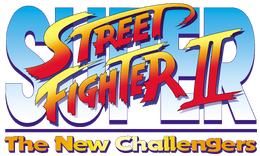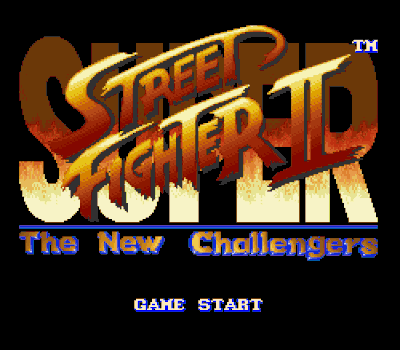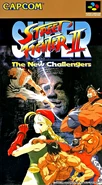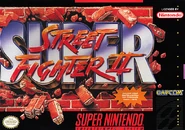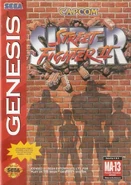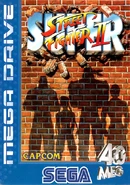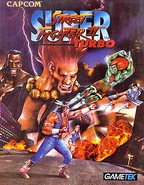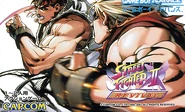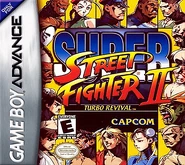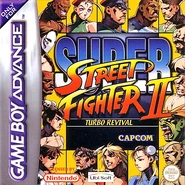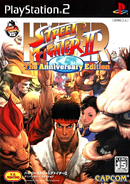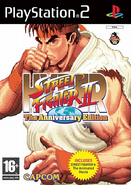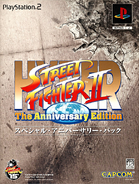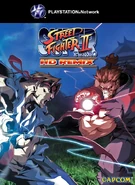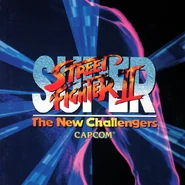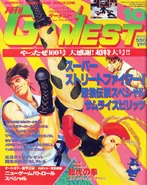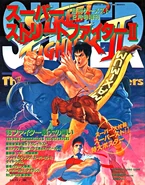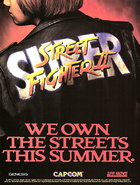| Line 3: | Line 3: | ||
==Gameplay== |
==Gameplay== |
||
| + | ===Changes and Improvements=== |
||
| − | {{Incomplete section}} |
||
| + | ''Super Street Fighter II'' features a new scoring system which kept track of combos, first attacks, reversals and recoveries made by the player and awards the player with bonus points by performing such deeds. |
||
| + | |||
| + | Another improvement from previous games was the reversal, allowing quick recovery into an attack after landing on the ground or blocking, thus negating the opportunity in previous incarnations of "ticking" one's opponent (i.e., hitting an opponent with a light attack and immediately throwing during their block animation. This was notable against large character such as [[E. Honda]]). |
||
| + | |||
| + | The faster game speed introduced in ''Hyper Fighting'' was removed and the gameplay is tweakable by pushing the control stick left or right at the title screen, between 1 to 4 stars, with four being the fastest. |
||
| + | |||
| + | New dizzy animations were also added (such as angels and reapers). Grim Reapers signified a dizzy that would be difficult to recover from, stars or birds represented a standard recovery time dizzy, and angels represented a dizzy that could be escaped from quickly. |
||
| + | |||
| + | Other subtle changes took place with most of the characters: new moves were added and parameters of the moves were altered, generally making the game more balanced than its previous iterations. |
||
| + | |||
| + | The number of "re-dizzy" combos were greatly reduced. Such combos involve executing an unblockable combination on a dizzied character that results in the target character becoming dizzy again. |
||
| + | |||
| + | Most of the graphics from the previous ''Street Fighter II'' games were either redrawn or recolored. All of the stages, face artwork, and the HUD feature all new graphics. The original opening sequence which featured two generic martial artists fighting in front of a crowd was replaced by a new opening featuring [[Ryu]] launching a Hadoken towards the screen. |
||
| + | |||
| + | New animation frames were drawn for all the characters for their basic and special moves, as well as new victory poses. For example, all four boss characters now have new animation frames for basic attacks ([[Vega]] and [[Sagat]] did not have jumping punches in the previous games), while [[Chun-Li]] now has a new animation for her Kikoken projectile technique. The music and sound effects were also remade and new voice samples were recorded for some of the characters. (i.e.: Ryu and [[Ken]] were given different voices) However, Ryu and [[Dhalsim]] still share the same groans when KO and when throwing the opponent. |
||
| + | |||
| + | Each character had available eight color schemes, depending on which button was pushed to select the character. Players could choose between a character's original color scheme, their color schemes from ''Champion Edition'' and ''Hyper Fighting'', or one of five new color schemes featured in the game. |
||
| + | |||
| + | ===Tournament Battle=== |
||
| + | In addition to the standard single and two-player game modes, ''Super Street Fighter II'' also feature an exclusive eight-player single-elimination tournament mode dubbed ''Tournament Battle''. This mode is only available when four ''Super Street Fighter II'' arcade game cabinets are connected together and all of them configured to "Tournament" mode. The Tournament Mode consists of three sets of four simultaneous matches: the initial eliminations, the semifinals and the finals. After the first set is over, the players are re-arranged accordingly based on their position: the winning players sent to either of the first two cabinets, whereas losing players sent to one of the other two. In the finals, the players competing for first place are sent to the first cabinet, the third-place players to the second cabinet, and so on. |
||
== Characters == |
== Characters == |
||
Revision as of 07:56, 7 March 2019
Super Street Fighter II - The New Challengers (スーパーストリートファイターⅡ, Sûpâ Sutorîto Faitâ Tsû?) is a Street Fighter game originally released as a coin-operated arcade game in 1993.

Super Street Fighter II Turbo HD Remix - ROUND 1 Trailer
Super Turbo HD Remix Trailer
It is the fourth arcade version of Street Fighter II produced, following Street Fighter II: The World Warrior, Street Fighter II: Champion Edition and Street Fighter II: Hyper Fighting. In addition to refining and balancing the existing character roster from the previous installments, Super Street Fighter II also introduced four new characters. It was also the first game to be developed on Capcom's CP System II hardware, which permitted more sophisticated graphics and audio over the original CP System hardware used by the previous versions of Street Fighter II.
Gameplay
Changes and Improvements
Super Street Fighter II features a new scoring system which kept track of combos, first attacks, reversals and recoveries made by the player and awards the player with bonus points by performing such deeds.
Another improvement from previous games was the reversal, allowing quick recovery into an attack after landing on the ground or blocking, thus negating the opportunity in previous incarnations of "ticking" one's opponent (i.e., hitting an opponent with a light attack and immediately throwing during their block animation. This was notable against large character such as E. Honda).
The faster game speed introduced in Hyper Fighting was removed and the gameplay is tweakable by pushing the control stick left or right at the title screen, between 1 to 4 stars, with four being the fastest.
New dizzy animations were also added (such as angels and reapers). Grim Reapers signified a dizzy that would be difficult to recover from, stars or birds represented a standard recovery time dizzy, and angels represented a dizzy that could be escaped from quickly.
Other subtle changes took place with most of the characters: new moves were added and parameters of the moves were altered, generally making the game more balanced than its previous iterations.
The number of "re-dizzy" combos were greatly reduced. Such combos involve executing an unblockable combination on a dizzied character that results in the target character becoming dizzy again.
Most of the graphics from the previous Street Fighter II games were either redrawn or recolored. All of the stages, face artwork, and the HUD feature all new graphics. The original opening sequence which featured two generic martial artists fighting in front of a crowd was replaced by a new opening featuring Ryu launching a Hadoken towards the screen.
New animation frames were drawn for all the characters for their basic and special moves, as well as new victory poses. For example, all four boss characters now have new animation frames for basic attacks (Vega and Sagat did not have jumping punches in the previous games), while Chun-Li now has a new animation for her Kikoken projectile technique. The music and sound effects were also remade and new voice samples were recorded for some of the characters. (i.e.: Ryu and Ken were given different voices) However, Ryu and Dhalsim still share the same groans when KO and when throwing the opponent.
Each character had available eight color schemes, depending on which button was pushed to select the character. Players could choose between a character's original color scheme, their color schemes from Champion Edition and Hyper Fighting, or one of five new color schemes featured in the game.
Tournament Battle
In addition to the standard single and two-player game modes, Super Street Fighter II also feature an exclusive eight-player single-elimination tournament mode dubbed Tournament Battle. This mode is only available when four Super Street Fighter II arcade game cabinets are connected together and all of them configured to "Tournament" mode. The Tournament Mode consists of three sets of four simultaneous matches: the initial eliminations, the semifinals and the finals. After the first set is over, the players are re-arranged accordingly based on their position: the winning players sent to either of the first two cabinets, whereas losing players sent to one of the other two. In the finals, the players competing for first place are sent to the first cabinet, the third-place players to the second cabinet, and so on.
Characters
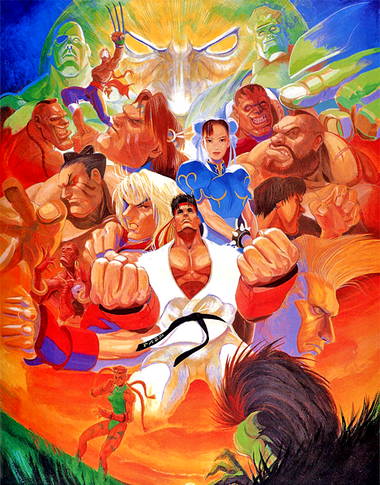
Art by Daichan
| Returning Characters |
|---|
| Balrog |
| Blanka |
| Chun-Li |
| Dhalsim |
| E. Honda |
| Guile |
| Ken Masters |
| M. Bison |
| Ryu |
| Sagat |
| Vega |
| Zangief |
| New Characters |
|---|
| Cammy |
| Dee Jay |
| Fei Long |
| T. Hawk |
| Akuma (Super Street Fighter II Turbo, secret character) |
| Shin Akuma (Super Street Fighter II Turbo, secret character) |
Updates
- Super Street Fighter II Turbo - (1994) - Super Street Fighter II X in Japan. - The game featured four speed settings (hence the name "Turbo") plus new moves and animations for all the existing characters, as well as the first appearance of the series' first hidden character Akuma. The game also introduced Super Combo techniques to the series.
- Super Street Fighter II Turbo Revival - (2001) - A port of the original SSFIIT for the Game Boy Advance with an all new title screen and character illustrations. Because the GBA only has four buttons installed on its hardware, the four action buttons can be easily customized. The character sprites and animations were transferred from the SNES version of the original Super Street Fighter II, the new techniques that were added from SSFIIT used the same sprites and animations from the arcade version.
- Super Street Fighter II Turbo HD Remix - (2008 - Downloadable Content) - The sprites and backgrounds in the original Super Street Fighter II Turbo were replaced by high-resolution artwork drawn by UDON Entertainment, allowing HD Remix to make the most use of high definition displays. However, the game can be changed back to the original sprites as an option. Remixed music was also developed, later revealed to be handled by video game music website OverClocked ReMix.
Compilations
- Street Fighter Collection - a compilation that contained Super Street Fighter II (and Turbo) and Street Fighter Alpha 2 Gold, was released for the PlayStation and Saturn in 1997. All three games were close to their arcade counterparts.
- Hyper Street Fighter II: The Anniversary Edition (ハイパーストリートファイターII, Haipā Sutorīto Faitā Tsū) is an arranged version of Super Street Fighter II Turbo with the ability to choose every previously playable version of the characters from all five arcade versions of Street Fighter II (including the alternate versions of the characters in Super Turbo). It was first released as a PlayStation 2 game, but was backported to the CPS-2 hardware and distributed in arcades in Japan and Asia. The game includes an option to switch between the CPS, CPS-2 and arranged (from the FM Towns version of Super and the 3DO version of Super Turbo) renditions of the game's soundtrack. The PS2 version of the game was sold as a stand-alone game in Japan and in the PAL region, and bundled with Street Fighter III 3rd Strike retitled Street Fighter Anniversary Collection in North America. This same bundle was released worldwide for the Xbox.
Credits
Arcade Version [Super Street Fighter II] [Staff]
Planner: Poo, Mucchi
Character Designer: Kurisan, Ikusan Z, Q, YORiO, Tanuki, Katuragi, Matunaga, Rikagon, Simpsons, Pei, Mikiman, Buppo, M.Okazaki, Taka, Akiko, K.Crown, Shibataro
Programmer: Shin., Kid, MiN, EGW, Aoi Mix, Tarabar
Music: Syun, Oyaji
Sound: Nobu., Toshio
Special Thanks: Nin, Akiman, CBX, Dr. Dave, Raven Jimenez, and Capcom All Staff
Presented by: Capcom
Arcade Version [Turbo] [Staff]
Planner: Poo, Mucchi, Hassy, Kimo Kimo
Character Designer: Akiman, Kurisan, Hayashi, Tanuki, Erichan, Ikusan.Z, Q, Yu-Suke, Youjiro, Inukichi, Fukumoyan, Buppo, Angus, SM, S.Kuwajima, Kisabon, Ohnishi.H, Takky, Matsuchan, May, Kazu, Iwai, N-Gawa, RK., Shochan
Programmer: Shin., MiN, Kid, Mitsu, Garamon, Domesan, Ouchi, Chabin, Kimoto, Inaba
Music: Syun, Oyaji
Sound: Nobu., Toshio
Special Thanks: CBX, EGW, Sado, Iizima, M.Michi, E-Bou., and Capcom All Staff
Presented by: Capcom
SNES and Genesis/Mega Drive Versions [Super Street Fighter II]
- Though credit lists don't exist for these versions, the default Ranking Display table does credit some of the game's staff:
- 1st 50000 LEO
- 2nd 45000 KRN
- 3th 40000 MAY
- 4th 35000 KAI
- 5th 30000 JUN
Dreamcast Version [for Matching Service]
Producer: Noritaka Funamizu, Yoshihiro Sudou
Programmer: Nobuaki Minomiya, Hisashi Kuramoto
Scroll Design: Yusuke Saiwai
Sound: Kondo "X68K" Hiroaki
Music: Yuko Takehara
Planner: Buruma (Kojimax)
Title Design: Ukabin
Instruction Card Design: Yuko Uchida
Network: Kaz Yunde, Kentaro Kaneko, Mineyuki Noda, Miss, Net Man, Shin.
Special Thanks: Cham, Meijin, Kouhei Akiyama, Tomohiro Ueno, Tsutomu Ikai
Test Player: Yoshihiro Tomita, Masayasu Mukai, Yuka Matsumi, Katsunori Shinano, Nozomu Umezono
General Producer: Noritaka Funamizu, Yoshiki Okamoto
Special Thanks (continued): and All Capcom Staff
Presented by: Capcom
GBA Version [Revival]
Director: Ohko 15 Matsumaru
Programmer: Giichi Ariyama, Kenichi Nishigaki, Seiya Okamoto, Kouhei Yamaguchi, Norio Maeda, Kenichi Arita, Masatsugu Shinohara, Yoshito Ito, Nobuaki Minomiya
BG Designer: Ryutaro's Mama
Designer: Hideaki Katagiri, Katsumi Toda, Junko Ikeda, Chizuko Tamura, Kenz. Yamahashi
Character Designer: Edayan
Sound: Tosio Kajino, Chihiro Arisaka
Bug Checker: YNG. J. Matsubara, Shosuke Suzuki, Hirotsugu Domae, Hiroyuki Yamamoto, Makoto Yasutomi, Junya Yosimura, Shohei Okamura, Noriyuki Iwata, Taro Suwabe
Manual: Sakomizu
Special Thanks: Erik Genazea Suzuki, Takuya Shiraiwa, Furu Tanuki
Producer: Koji Nakajima, Tatsuya Minami
Executive Producer: Yoshiki Okamoto
PS2 Version [Hyper]
Planner: Oni-Suzuki
Programmer: Shin., Hard.Yas, Meijin, Hyper Shinchan, Yu Kawamura, Yoji Mikami, Senor
Special Programmer: Nobuaki Minomiya
Title Designer: Ukabin
Instruction Card Designer: Masako Honma, Minoru Nagaoka
Scroll Designer: Yoko Fukumoto, Kuwajima.C-Ya.R-W, Alecky.Eh
Sound Designer: Hiroaki "X68K" Kondo
Music Arranger: Mitsuhiko Takano
Producer: Kenzy Itsuno
Executive Producer: Yoshihiro Sudo
Executive Director: Noritaka Funamizu
Special Thanks: Satoshi Ise, Neo-G (H.Ishizawa), Matsukuni, Bug (Skill Smith), Ru-Pin, M.Masa, and Capcom All Staff
Presented by: Capcom
Arcade Version [Hyper]
Planner: Oni-Suzuki, Mo-Z
Programmer: Shin., Hard.Yas, Meijin, Hyper Shinchan, Yu Kawamura, Yoji Mikami, Senor, .Seta
Special Programmer: Nobuaki Minomiya
Title Designer: Ukabin
Instruction Card Designer: Masako Honma, Minoru Nagaoka
Scroll Designer: Yoko Fukumoto, Kuwajima.C-Ya.R-W, Alecky.Eh
Sound Designer: Hiroaki X68K Kondo
Music Arranger: Mitsuhiko Takano
Producer: Kenzy Itsuno
Executive Producer: Yoshihiro Sudo
Executive Director: Noritaka Funamizu
Special Thanks: Satoshi Ise, Neo-G (H.Ishizawa), Matsukuni, Takashi Kubozono, Toru Kusano, Masayuki Fukumoto, Noriko Kato, Bug (Skill Smith), Ru-Pin, M.Masa, and Capcom All Staff
Presented by: Capcom
Gallery
Box Art
Merchandise and Advertisement
References

